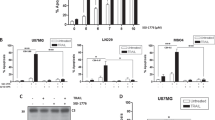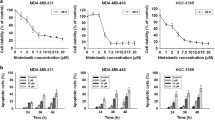Abstract
Gefitinib, a selective epidermal growth factor receptor tyrosine kinase inhibitor, is under clinical testing and use in cancer patients, including glioma. However, the molecular mechanisms involved in gefitinib-mediated anticancer effects against glioma remain largely uncharacterized. Gefitinib inhibits cell growth and induces apoptosis in human glioma cells. Gefitinib also induces death of H4 cells with characteristics of the intrinsic apoptotic pathway, including Bax mitochondrial translocation, mitochondrial outer membrane permeabilization, cytochrome c cytosolic release, and caspase-9/caspase-3 activation. The importance of Bax in mediating gefitinib-induced apoptosis was confirmed by the attenuation of apoptosis by Bax siRNA and Bax channel blocker. Gefitinib caused Bad dephosphorylation, particularly in serine-112, and increased its binding preference to Bcl-2 and Bcl-xL. The dephosphorylation of Bad in gefitinib-treated cells was accompanied by reduced intracellular cyclic AMP content and protein kinase A (PKA) activity. Adenylyl cyclase activator forskolin attenuated, but PKA inhibitor H89 augmented, gefitinib-induced Bad dephosphorylation, Bax mitochondrial translocation, caspase-9/caspase-3 activation, and viability loss. Intriguingly, a nonselective protein phosphatase inhibitor okadaic acid alleviated gefitinib-induced alterations, except Bad dephosphorylation. In parallel with the higher basal PKA activity, response of U87 cells to gefitinib treatment was delayed and relatively resistant compared with that of H4 and T98G cells. Inactivation of PKA sensitized H4, T98G, and U87 cells to gefitinib cytotoxicity, Bad dephosphorylation in serine-112, and caspase-9/caspase-3 activation. Our findings suggest the involvement of the Bad/Bax signaling pathway in gefitinib-induced glioma apoptosis. Furthermore, the inactivation of PKA was shown to play a role in triggering the proapoptotic function of Bad.










Similar content being viewed by others
References
Nagane M, Huang HJ, Cavenee WK (1997) Advances in the molecular genetics of gliomas. Curr Opin Oncol 9:215–222
Soni D, King JA, Kaye AH, Hovens CM (2005) Genetics of glioblastoma multiforme: mitogenic signaling and cell cycle pathway converge. J Clin Neurosci 12:1–5
Lund-Johansen M, Bjerkvig R, Humphrey PA, Bigner SH, Bigner DD, Laerum OD (1990) Effect of epidermal growth factor receptor on glioma cell growth, migration, and invasion in vitro. Cancer Res 50:6039–6044
Culy CR, Faulds D (2002) Gefitinib. Drugs 62:2237–2248
Frampton JE, Easthope SE (2005) Spotlight on gefitinib in non-small cell lung cancer. Am J Pharmacogen 5:133–136
Paez JG, Jänne PA, Lee JC, Tracy S, Greulich H, Gabriel S, Herman P, Kaye FJ, Lindeman N, Boggon TJ, Naoki K, Sasaki H, Fujii Y, Eck MJ, Sellers WR, Johnson BE, Meyerson M (2004) EGFR mutations in lung cancer: correlation with clinical response to gefitinib therapy. Science 304:1497–1500
Chan SK, Gullick WJ, Hill ME (2006) Mutations of the epidermal growth factor receptor in non-small cell lung cancer-search and destroy. Eur J Cancer 42:17–23
Wakeling AE, Guy SP, Woodburn JR, Ashton SE, Curry BJ, Barker AJ, Gibson KH (2002) ZD1839 (Iressa): an orally active inhibitor of epidermal growth factor signaling with potential for cancer therapy. Cancer Res 62:5749–5754
Nishikawa R, Ji XD, Harmon RC, Lazar CS, Gill GN, Cavenee WK, Huang HJ (1994) A mutant epidermal growth factor receptor common in human glioma confers enhanced tumorigenicity. Proc Natl Acad Sci USA 91:7727–7731
Wong AJ, Ruppert JM, Bigner SH, Grzeschik CH, Humphrey PA, Bigner DS, Vogelstein B (1992) Structural alterations of the epidermal growth factor receptor gene in human gliomas. Proc Natl Acad Sci USA 89:2965–2969
Premkumar DR, Arnold B, Pollack IF (2006) Cooperative inhibitory effect of ZD1839 (Iressa) in combination with 17-AAG on glioma cell growth. Mol Carcinog 45:288–301
Rich JN, Reardon DA, Peery T, Dowell JM, Quinn JA, Penne KL, Wikstrand CJ, Van Duyn LB, Dancey JE, McLendon RE, Kao JC, Stenzel TT, Ahmed Rasheed BK, Tourt-Uhlig SE, Herndon JE 2nd, Vredenburgh JJ, Sampson JH, Friedman AH, Bigner DD, Friedman HS (2004) Phase II trial of gefitinib in recurrent glioblastoma. J Clin Oncol 22:133–142
Jiang Z, Zheng X, Rich KM (2003) Down-regulation of Bcl-2 and Bcl-xL expression with bispecific antisense treatment in glioblastoma cell lines induce cell death. J Neurochem 84:273–281
Ichinose M, Liu XH, Hagihara N, Youle RJ (2002) Extracellular Bad fused to toxin transport domains induces apoptosis. Cancer Res 62:1433–1438
Cartron PF, Oliver L, Martin S, Moreau C, LeCabellec MT, Jezequel P, Meflah K, Vallette FM (2002) The expression of a new variant of the pro-apoptotic molecule Bax, Baxpsi, is correlated with an increased survival of glioblastoma multiforme patients. Hum Mol Genet 11:675–687
Busser B, Sancey L, Josserand V, Niang C, Favrot MC, Coll JL, Hurbin A (2010) Amphiregulin promotes BAX inhibition and resistance to gefitinib in non-small-cell lung cancers. Mol Ther 18:528–535
Youle RJ, Strasser A (2008) The BCL-2 protein family: opposing activities that mediate cell death. Nat Rev Mol Cell Biol 9:47–59
Raung SL, Chen SY, Liao SL, Chen JH, Chen CJ (2007) Japanese encephalitis virus infection stimulates Src tyrosine kinase in neuron/glia. Neurosci Lett 419:263–268
Kroemer G, Galluzzi L, Brenner C (2007) Mitochondrial membrane permeabilization in cell death. Physiol Rev 87:99–163
Das A, Banik NL, Ray SK (2010) Flavonoids activated caspases for apoptosis in human glioblastoma T98G and U87MG cells but not in human normal astrocytes. Cancer 116:164–176
Oka N, Wang L, Mi W, Zhu W, Honjo O, Caldarone CA (2008) Cyclosporine A prevents apoptosis-related mitochondrial dysfunction after neonatal cardioplegic arrest. J Thorac Cardiovasc Surg 135:123–130
Harada H, Becknell B, Wilm M, Mann M, Huang LJ, Taylor SS, Scott JD, Korsmeyer SJ (1999) Phosphorylation and inactivation of BAD by mitochondria-anchored protein kinase A. Mol Cell 3:413–422
Chang GC, Hsu SL, Tsai JR, Liang FP, Lin SY, Sheu GT, Chen CY (2004) Molecular mechanisms of ZD1839-induced G1-cell cycle arrest and apoptosis in human lung adenocarcinoma A549 cells. Biochem Pharmacol 68:1453–1464
Chang GC, Yu CT, Tsai CH, Tsai JR, Chen JC, Wu CC, Wu WJ, Hsu SL (2008) An epidermal growth factor inhibitor, gefitinib, induces apoptosis through a p53-dependent upregulation of pro-apoptotic molecules and downregulation of anti-apoptotic molecules in human lung adenocarcinoma A549 cells. Eur J Pharmacol 600:37–44
Piechocki MP, Yoo GH, Dibbley SK, Amjad EH, Lonardo F (2006) Iressa induces cytostasis and augments Fas-mediated apoptosis in acinic cell adenocarcinoma overexpressing HER2/neu. Int J Cancer 119:441–454
Rho JK, Choi YJ, Ryoo BY, Na II, Yang SH, Kim CH, Lee JC (2007) p53 enhances gefitinib-induced growth inhibition and apoptosis by regulation of Fas in non-small cell lung cancer. Cancer Res 67:1163–1169
Ariyama H, Qin B, Baba E, Tanaka R, Mitsugi K, Harada M, Nakano S (2006) Gefitinib, a selective EGFR tyrosine kinase inhibitor, induces apoptosis through activation of Bax in human gallbladder adenocarcinoma cells. J Cell Biochem 97:724–734
Cragg MS, Kuroda J, Puthalakath H, Huang DCS, Strasser A (2007) Gefitinib-induced killing of NSCLC cell lines expressing mutant EGFR requires BIM and can be enhanced by BH3 mimetics. PLoS Med 4:e316
Sun Q, Ming L, Thomas SM, Wang Y, Chen ZG, Ferris RL, Grandis JR, Zhang L, Yu J (2009) PUMA mediates EGFR tyrosine kinase inhibitor-induced apoptosis in head and neck cancer cells. Oncogene 28:2348–2357
Danial NN (2009) BAD: undertaker by night, candyman by day. Oncogene 27:553–570
Zha J, Harada H, Yang E, Jocker J, Korsmeyer SJ (1996) Serine phosphorylation of death agonist BAD in response to survival factor results in binding to 14-3-3 not BCL-X(L). Cell 87:619–628
Chiang CW, Kanies C, Kim KW, Fang WB, Parkhurst C, Xie M, Henry T, Yang E (2003) Protein phosphatase 2A dephosphorylation of phosphoserine 112 plays the gatekeeper role for BAD-mediated apoptosis. Mol Cell Biol 23:6350–6362
Datta SR, Dudek H, Tao X, Masters S, Fu H, Gotoh Y, Greenberg ME (1997) Akt phosphorylation of BAD couples survival signals to the cell-intrinsic death machinery. Cell 91:231–241
Shimamura A, Ballif BA, Richards SA, Blenis J (2000) Rsk1 mediates a MEK-MAP kinase cell survival signal. Curr Biol 10:127–135
Tortora G, Caputo R, Damiano V, Fontanini G, Melisi D, Veneziani BM, Zunino F, Bianco AR, Ciardiello F (2001) Oral administration of a novel taxane, an antisense oligonucleotide targeting protein kinase A, and the epidermal growth factor receptor inhibitor Iressa causes cooperative antitumor and antiangiogenesis activity. Clin Cancer Res 7:4156–4163
Cohen P, Holmes CFB, Tsukitani Y (1990) Okadaic acid: a new probe for the study of cellular regulation. Trends Biochem Sci 15:98–102
Xin M, Deng X (2006) Protein phosphatase 2A enhances the proapoptotic function of Bax through dephosphorylation. J Biol Chem 281:18859–18867
Garibal J, Hollville É, Renouf B, Tétaud C, Wiels J (2010) Caspase-8-mediated cleavage of Bid and protein phosphatase 2A-mediated activation of Bax are necessary for verotoxin-1-induced apoptosis in Burkitt’s lymphoma cells. Cell Signal 22:467–475
Mellinghoff IK, Wang MY, Vivanco I, Haas-Kogan DA, Zhu S, Dia EQ, Lu KV, Yoshimoto K, Huang JH, Chute DJ, Riggs BL, Horvath S, Liau LM, Cavenee WK, Rao PN, Beroukhim R, Peck TC, Lee JC, Sellers WR, Stokoe D, Prados M, Cloughesy TF, Sawyers CL, Mischel PS (2005) Molecular determinants of the response of glioblastomas to EGFR kinase inhibitors. N Engl J Med 353:2012–2024
Krex D, Mohr B, Hauses M, Ehninger G, Schackert HK, Schackert G (2001) Identification of uncommon chromosomal aberrations in the neuroglioma cell line H4 by spectral karyotyping. J Neurooncol 52:119–128
Rubenstein M, Shaw M, Mirochnik Y, Slobodskoy L, Glick R, Lichtor T, Chou P, Guinan P (1999) In vivo establishment of T98G human glioblastoma. Methods Find Exp Clin Pharmacol 21:391–393
Zhang R, Banik NL, Ray SK (2007) Combination of all-trans retinoic acid and interferon-gamma suppressed PI3K/Akt survival pathway in glioblastoma T98G cells whereas NF-κB survival signaling in glioblastoma U87MG cells for induction of apoptosis. Neurochem Res 32:2194–2202
Lal B, Goodwin CR, Sang Y, Foss CA, Cornet K, Muzamil S, Pomper MG, Kim J, Laterra J (2009) EGFRvIII and c-Met pathway inhibitors synergize against PTEN-null/EGFRvIII+ glioblastoma xenografts. Mol Cancer Ther 8:1751–1760
Tamura S, Hosoi H, Kuwahara Y, Kikuchi K, Otabe O, Izumi M, Tsuchiya K, Iehara T, Gotoh T, Sugimoto T (2007) Induction of apoptosis by an inhibitor of EGFR in neuroblastoma cells. Biochem Biophys Res Commun 358:226–232
Nakagawa K, Tamura T, Negoro S, Kudoh S, Yamamoto N, Yamamoto N, Takeda K, Swaisland H, Nakatani I, Hirose M, Dong RP, Fukuoka M (2003) Phase I pharmacokinetic trial of the inhibitor gefitinib (Iressa, ZD1839) in Japanese patients with solid malignant tumors. Ann Oncol 14:922–930
Cemeus C, Zhao TT, Barrett GM, Lorimer IA, Dimitroulakos J (2008) Lovastatin enhances gefitinib activity in glioblastoma cells irrespective of EGFRvIII and PTEN status. J Neurooncol 90:9–17
Doherty L, Gigas DC, Kesari S, Drappatz J, Kim R, Zimmerman J, Ostrowsky L, Wen PY (2006) Pilot study of the combination of EGFR and mTOR inhibitors in recurrent malignant gliomas. Neurology 67:156–158
Geoerger B, Gaspar N, Opolon P, Morizet J, Devanz P, Lecluse Y, Valent A, Lacroix L, Grill J, Vassal G (2008) EGFR tyrosine kinase inhibition radiosensitizes and induces apoptosis in malignant glioma and childhood ependymoma xenografts. Int J Cancer 123:209–216
Gustafson DL, Frederick B, Merz AL, Raben D (2008) Dose scheduling of the dual VEGFR and EGFR tyrosine kinase inhibitor vandetanib (ZD6474, Zactima) in combination with radiotherapy in EGFR-positive and EGFR-null human head and neck tumor xenografts. Cancer Chemother Pharmacol 61:179–188
Hegi ME, Diserens AC, Bady P, Kamoshima Y, Kouwenhoven MCM, Delorenzi M, Lambiv WL, Hamou MF, Matter MS, Koch A, Heppner FL, Yonekawa Y, Merlo A, Frei K, Mariani L, Hofer S (2010) Pathway analysis of glioblastoma tissue after preoperative treatment with the EGFR tyrosine kinase inhibitor gefitinib—a phase II trial. Mol Cancer Ther. 10(6):1102–1112. doi:10.1158/1535-7163.MCT-11-0048
Acknowledgments
This study was supported by grants from Central Region Hospital Alliance, Department of Health, Taiwan, ROC (9909) and the Yen Tjing Ling Medical Foundation (CI-97-11). The authors thank AstraZeneca (Cheshire, UK) for the donation of gefitinib.
Author information
Authors and Affiliations
Corresponding authors
Rights and permissions
About this article
Cite this article
Chang, CY., Shen, CC., Su, HL. et al. Gefitinib induces apoptosis in human glioma cells by targeting Bad phosphorylation. J Neurooncol 105, 507–522 (2011). https://doi.org/10.1007/s11060-011-0632-3
Received:
Accepted:
Published:
Issue Date:
DOI: https://doi.org/10.1007/s11060-011-0632-3




